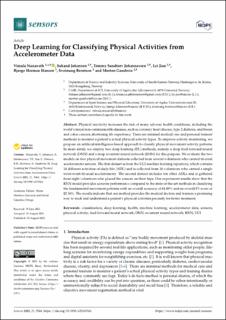| dc.contributor.author | Nunavath, Vimala | |
| dc.contributor.author | Johansen, Sahand | |
| dc.contributor.author | Johannessen, Tommy Sandtorv | |
| dc.contributor.author | Jiao, Lei | |
| dc.contributor.author | Hansen, Bjørge Hermann | |
| dc.contributor.author | Stølevik, Sveinung Berntsen | |
| dc.contributor.author | Goodwin, Morten | |
| dc.date.accessioned | 2021-12-08T15:01:32Z | |
| dc.date.available | 2021-12-08T15:01:32Z | |
| dc.date.created | 2021-09-21T15:04:05Z | |
| dc.date.issued | 2021-08-18 | |
| dc.identifier.citation | Sensors. 2021, 21 (16), . | en_US |
| dc.identifier.issn | 1424-8220 | |
| dc.identifier.uri | https://hdl.handle.net/11250/2833441 | |
| dc.description.abstract | Physical inactivity increases the risk of many adverse health conditions, including the world’s major non-communicable diseases, such as coronary heart disease, type 2 diabetes, and breast and colon cancers, shortening life expectancy. There are minimal medical care and personal trainers’ methods to monitor a patient’s actual physical activity types. To improve activity monitoring, we propose an artificial-intelligence-based approach to classify physical movement activity patterns. In more detail, we employ two deep learning (DL) methods, namely a deep feed-forward neural network (DNN) and a deep recurrent neural network (RNN) for this purpose. We evaluate the two models on two physical movement datasets collected from several volunteers who carried tri-axial accelerometer sensors. The first dataset is from the UCI machine learning repository, which contains 14 different activities-of-daily-life (ADL) and is collected from 16 volunteers who carried a single wrist-worn tri-axial accelerometer. The second dataset includes ten other ADLs and is gathered from eight volunteers who placed the sensors on their hips. Our experiment results show that the RNN model provides accurate performance compared to the state-of-the-art methods in classifying the fundamental movement patterns with an overall accuracy of 84.89% and an overall F1-score of 82.56%. The results indicate that our method provides the medical doctors and trainers a promising way to track and understand a patient’s physical activities precisely for better treatment. | en_US |
| dc.language.iso | eng | en_US |
| dc.publisher | MDPI | en_US |
| dc.relation.ispartofseries | Sensors;Volume 21 / Issue 16 | |
| dc.rights | Navngivelse 4.0 Internasjonal | * |
| dc.rights.uri | http://creativecommons.org/licenses/by/4.0/deed.no | * |
| dc.subject | Deep learning | en_US |
| dc.subject | Helse | en_US |
| dc.subject | Health | en_US |
| dc.subject | Physical activity | en_US |
| dc.subject | Fysisk aktiviteter | en_US |
| dc.subject | Physical activities | en_US |
| dc.subject | Classifications | en_US |
| dc.subject | Machine learning | en_US |
| dc.subject | Accelerometer data | en_US |
| dc.subject | Sensors | en_US |
| dc.subject | Feed-forward neural networks | en_US |
| dc.subject | Recurrent neural networks | en_US |
| dc.title | Deep Learning for Classifying Physical Activities from Accelerometer Data | en_US |
| dc.type | Peer reviewed | en_US |
| dc.type | Journal article | en_US |
| dc.description.version | publishedVersion | en_US |
| dc.rights.holder | © 2021 by the authors. | en_US |
| dc.source.articlenumber | 5564 | en_US |
| cristin.ispublished | true | |
| cristin.fulltext | original | |
| cristin.qualitycode | 1 | |
| dc.identifier.doi | https://doi.org/10.3390/s21165564 | |
| dc.identifier.cristin | 1936674 | |
| dc.source.journal | Sensors | en_US |
| dc.source.volume | 21 | en_US |
| dc.source.issue | 16 | en_US |
| dc.source.pagenumber | 28 | en_US |
| dc.subject.nsi | VDP::Informasjons- og kommunikasjonsteknologi: 550 | en_US |
| dc.subject.nsi | VDP::Information and communication technology: 550 | en_US |

